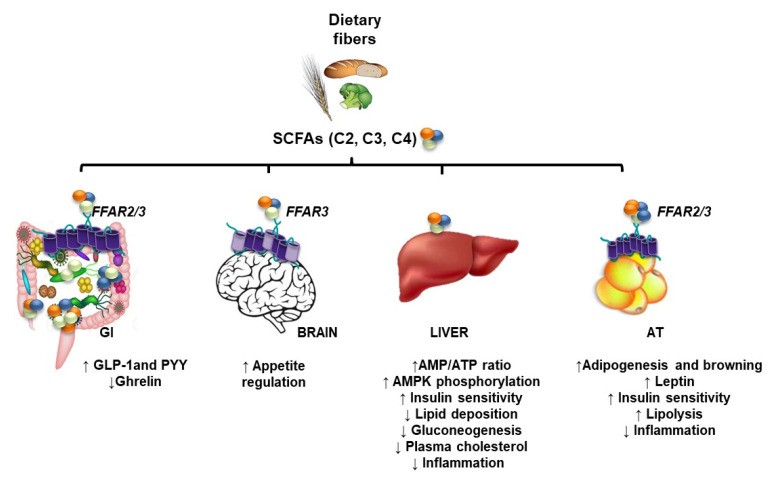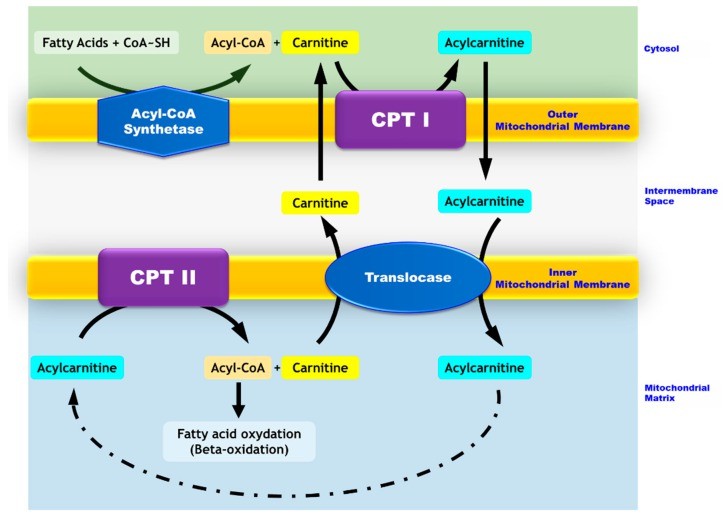Fatty acids constitute fundamental structural elements within lipid compounds, ubiquitously present in biological systems and dietary sources. Classification based on hydrocarbon chain length categorizes them as short-chain (SCFAs), medium-chain (MCFAs), and long-chain fatty acids (LCFAs). Crucially, these biomolecules transcend mere energetic substrates—their carbon chain length operates as a molecular cipher dictating absorption mechanisms, metabolic pathways, and physiological utilization. This review systematically elucidates core structural and functional distinctions, with particular emphasis on comparative analysis between LCFAs and SCFAs.
Fatty Acid Classification: Structural Determinants and Functional Implications
1. Molecular Foundations of Chain Length Effects
The carboxylic acid-hydrocarbon chain structure dictates fundamental properties:
- Polarity Gradient: Short-chain dominance enhances hydrophilicity; extended chains increase hydrophobicity
- Thermal Transitions: Boiling/melting points rise with carbon count (e.g., butyrate: 163°C → stearate: 383°C)
- Spatial Configuration: Long chains adopt crystalline (saturated) or bent (unsaturated) conformations
Classification Framework:
- SCFAs (C2-C5): High aqueous solubility enabling membrane diffusion
- MCFAs (C6-C12): Balanced lipophilicity-metabolism profile
- LCFAs (≥C13): Extreme hydrophobicity requiring transport proteins
Solubility Spectrum by Chain Length
- SCFAs: Elevated carboxyl group density (e.g., acetate's -COOH constitutes 40% molecular mass) enables complete aqueous miscibility (butyrate solubility: 200g/L)
- MCFAs: Hydrocarbon chain dominance reduces hydrophilicity (caprylate solubility: 0.7g/L), necessitating bile salt emulsification for absorption
- LCFAs: Pronounced hydrophobic character (stearate solubility: 0.003g/L) mandates mixed micelle formation via bile acid conjugation
Chain Length-Specific Absorption Pathways
| Category | Primary Absorption Site | Key Transport Mechanisms |
|---|---|---|
| SCFAs | Colonic epithelium | Passive diffusion + MCT1/SMCT1 carrier-mediated uptake |
| MCFAs | Small intestine | Portal vein direct transfer (>70%) + lymphatic diffusion + MCT1 active transport |
| LCFAs | Small intestine | Chylomicron-dependent lymphatic trafficking via FATP4/CD36/FABPpm protein complex |
2. Chain Length Classification: Defining Critical Thresholds
Short-Chain Fatty Acids (SCFAs): C2-C5
- Primary Constituents: Monocarboxylic acid with < 6 carbon atoms
- Main components: acetate (C2, 60-70%), propionate (C3, 20-25%) and butyrate (C4, 10-15%), with a molar ratio of about 3:1:1.
- Production Mechanism: Microbial fermentation of dietary fiber (prebiotics) predominantly within the colonic lumen
- Metabolic Fate:
- Direct oxidation by colonic epithelia (butyrate serves as principal energy substrate)
- Systemic circulation following absorption to mediate physiological effects
- Key Functions: Intestinal homeostasis maintenance (mucus stimulation, barrier reinforcement, anti-inflammatory activity), immunomodulation, and energy balance regulation
 Overview of short chain fatty acids (SCFAs) (May KS et al., 2023)
Overview of short chain fatty acids (SCFAs) (May KS et al., 2023)
Medium-Chain Fatty Acids (MCFAs): C6-C12
- Representative Species: Caproic (C6), caprylic (C8), capric (C10), lauric (C12) acids
- Dietary Sources: Coconut/palm kernel oils, human milk, dairy fats, medical-grade MCT formulations. It naturally exists in animal and plant materials, but its abundance is significantly lower than that of long-chain fatty acids (LCFAs).
- Metabolic Attributes:
- Bile-independent absorption
- Portal vein delivery to hepatocytes
- Carnitine-independent mitochondrial β-oxidation
- Rapid ketogenesis and energy yield (beneficial in malabsorptive conditions)
- Physiological Roles: Rapid caloric provision, therapeutic applications (refractory epilepsy, nutritional support), antimicrobial activity
Long-Chain Fatty Acids (LCFAs): ≥C13
- Major Examples:
- Saturated: Myristic (C14), palmitic (C16), stearic (C18)
- Unsaturated: Oleic (C18:1), linoleic (C18:2ω6), α-linolenic (C18:3ω3), EPA (C20:5ω3), DHA (C22:6ω3)
- Primary Sources: Plant oils (soybean, canola, olive), animal fats, fish, nuts, eggs (predominant dietary lipids)
- Metabolic Processing:
- Bile-dependent micelle formation
- Enterocyte re-esterification into chylomicrons
- Lymphatic transport → systemic distribution
- Carnitine-dependent mitochondrial import
- Essential Functions:
- Primary energy reservoir and structural membrane components (modulating fluidity)
- Essential fatty acid provision (linoleic/α-linolenic acid)
- Neurological/cardiovascular support (ω-3 LCFAs)
- Eicosanoid precursor synthesis
For more information on long-chain fatty acids, please refer to "What Are Long-Chain Fatty Acids? A Beginner's Guide".
For more information on long-chain fatty acid analysis strategies, please refer to "Analytical Strategies for Long-Chain Fatty Acids Profiling".
Fatty Acid Physicochemical Properties Comparison
| Property | SCFAs (C2-C6) | MCFAs (C7-C12) | LCFAs (≥C13) |
|---|---|---|---|
| Chain Length | 2-6 carbons | 7-12 carbons | ≥13 carbons |
| Physical State (RT) | Liquid | Liquid (≤C9) / Solid (>C9) | Solid (sat.) / Liquid (unsat.)† |
| Representatives | Acetate (C2), Butyrate (C4) | Caprylate (C8), Laurate (C12) | Palmitate (C16), Oleate (C18:1) |
| Odor Profile | Pungent (high volatility) | Mild/rancid or odorless | Wax-like/odorless |
| Lipophilicity (LogP) | Low (-0.17 to 0.8)‡ | Moderate (1.5-3.5)‡ | High (5.0-7.5)‡ |
| Micelle Formation | Non-viable | Limited | Essential§ |
| Aqueous Solubility | High (C2: miscible) | Low (C8: 0.7g/L) | Very low (C18:0: 0.003g/L) |
| Volatility | High | Moderate | Negligible |
Key Supplementary Notes
Mechanism of micelle formation
- LCFAs: rely on self-assembly of hydrophobic tail chains to form mixed micelles (4-8 nm in diameter) with the assistance of bile salts. Achieve intestinal absorption.
- SCFA/MCFA: unable to form micelles due to short carbon chains that do not provide sufficient hydrophobic driving force, absorbed by diffusion in free acid or ionic state.
Cut-off point for state transition
- Liquid range: chain length ≤ 9 carbons (e.g. nonanoic acid C9 melting point 12.5°C) is liquid at room temperature, decanoic acid (C10) is the critical point for transition from liquid to solid state (melting point 31.6°C).
- Solid LCFAs: Saturated LCFAs (e.g. myristic acid C14, melting point 54°C) are solid at room temperature, and unsaturated LCFAs (e.g. oleic acid C18:1, melting point 13°C) can be liquid.
Quantitative indicators of lipophilicity
- logP values (octanol/water partition coefficient):
- Acetic acid (C2): logP = -0.17
- Caprylic acid (C8): logP = 3.05
- Palmitic acid (C16): logP = 7.10
→ For every 2 carbon increase in chain length, the logP value rises by about 0.8-1.0 units and lipophilicity is significantly increased.
Biological significance
- SCFA high water solubility: facilitates direct absorption by the colonic epithelium (e.g. butyric acid feeds colonic cells).
- LCFA micelle-dependent: determines that they must be transported through the lymphatic system (the celiac pathway), whereas MCFAs can enter the liver directly in the portal vein.
Metabolic Pathway Divergence: From Digestion to Cellular Energetics
1. Long-Chain Fatty Acids (LCFAs): Complex Processing Cascade
- Emulsification Criticality: Bile salts reduce interfacial tension, expanding lipase-accessible surface area 100-fold
- Enterocyte Reassembly: Intestinal mucosal cells synthesize triglycerides via acyltransferase (DGAT)-mediated conjugation of LCFAs with 2-monoacylglycerol
- Chylomicron Biogenesis: Requires Apob48 structural scaffolding—deficiencies cause chylomicron retention disease
- Mitochondrial Gatekeeping: CPT1 (carnitine palmitoyltransferase 1) activity is negatively regulated by malonyl-CoA, representing a crucial glucose-lipid metabolism intersection
 Mitochondrial transport of long-chain fatty acids (Blah N et al., 2018)
Mitochondrial transport of long-chain fatty acids (Blah N et al., 2018)
2. Medium-Chain Fatty Acids (MCFAs): Metabolic Streamlining
- Mitochondrial Privilege: Fatty acids
- Ketogenic Efficiency Gradient:
- Caprylate (C8): 4.2 μmol/g liver/min
- Laurate (C12): 1.8 μmol/g liver/min (57% reduction)
- Energy Yield Advantage: MCFAs generate ATP 3.2× faster than LCFAs (Am J Clin Nutr 1992)
- Ketogenic Efficiency Gradient:
3. Short-Chain Fatty Acids (SCFAs): Gut-Centric Metabolism
- Microbial-Host Synergy: Faecalibacterium prausnitzii ferments resistant starch at 2.8g/g substrate efficiency
- Epigenetic Modulation: Butyrate-mediated HDAC3 inhibition upregulates occludin expression 250%, enhancing barrier function
- Receptor-Mediated Signaling:
- Acetate → GPR43 activation → GLP-1 secretion (↑30%) → Glycemic control
- Propionate → GPR41 activation → Treg cell expansion → Anti-inflammatory response
Services You May Be Interested In:
Functional Implications of Fatty Acid Chain Length Classification
While carbon atom count forms the primary classification basis, notable boundary exceptions and specialized subgroups demand consideration in practical applications. Short-chain fatty acids (SCFAs, C2-C5), predominantly generated through colonic microbial fermentation of dietary fiber, function as immediate energy sources for gut epithelial cells (with butyrate serving as the principal substrate) while concurrently regulating immune responses and barrier integrity. Medium-chain fatty acids (MCFAs, C6-C12), prevalent in coconut oil and therapeutic MCT preparations, display distinctive metabolic characteristics: bile salt-independent absorption, carnitine shuttle bypass, and rapid ketone body production via hepatic portal transport. However, two significant boundary anomalies merit attention:
Metabolic Hybridity of Lauric Acid (C12)
Despite its MCFA classification, approximately 30% undergoes lymphatic absorption resembling LCFAs, demonstrating substantially reduced metabolic velocity compared to C8/C10 compounds. This necessitates strategic formulation differentiation: purified MCT oils (emphasizing C8/C10) maximize rapid energy release, while coconut oil (containing ~50% lauric acid) warrants distinct metabolic evaluation.
Physicochemical Singularities of Caproic Acid (C6)
This MCFA exhibits enhanced water solubility and distinctive odor relative to typical medium-chain analogs. Although partial aqueous-phase diffusion occurs during intestinal uptake, its primary metabolic pathway follows portal venous delivery to the liver.
Chain Length-Dependent Physicochemical Properties
Carbon chain length dictates fundamental molecular behaviors:
- Solubility Spectrum:
- SCFAs (e.g., acetate, butyrate): Complete water miscibility and volatility
- MCFAs: Sharp hydrophilicity decline with elongation (C6: partial solubility → C12: near-insolubility)
- LCFAs (≥C14): Extreme hydrophobicity with solid/semi-solid states at ambient temperature
- Practical Ramifications:
- LCFAs constitute optimal lipid nanoparticle cores where chain length and unsaturation govern stability
- SCFA therapeutics require advanced delivery systems (e.g., prodrugs, microencapsulation) to address rapid clearance
Thermal Behavior and Membrane Interactions:
Melting points of saturated chains increase progressively with carbon number (butyrate: -8°C → stearate: 69°C), while unsaturation depresses phase transition temperatures. Very-long-chain PUFAs (VLCFAs ≥C20; e.g., DHA, EPA) serve as critical modulators of membrane fluidity and synaptic efficacy through their pronounced unsaturation profiles.
VLCFAs: Structural and Metabolic Specialization
These elongated molecules (e.g., DHA C22:6, arachidonate C20:4) perform unique biological functions:
- Fundamental components of neuronal and retinal membranes regulating structural curvature
- Essential precursors for sphingolipid biosynthesis supporting neural myelination
- Peroxisome-initiated β-oxidation (defects cause pathologies like X-linked adrenoleukodystrophy)
Metabolic Limitations and Translational Applications
Essential Fatty Acid Conversion Constraints:
- ω-6 pathway: Linoleate (C18:2) → Arachidonate (C20:4)
- ω-3 pathway: α-Linolenate (ALA, C18:3) → EPA (C20:5) → DHA (C22:6)
- Human ALA→EPA/DHA conversion efficiency remains below 5%, justifying direct VLC-PUFA supplementation for neuroprotective and cardioprotective benefits.
Butyrate-Ketone Metabolic Dichotomy: Colonic butyrate (SCFA) operates through local mechanisms, whereas systemic ketone bodies (e.g., β-hydroxybutyrate) originate from hepatic breakdown of LCFAs—representing functionally distinct metabolic pathways.
Fatty Acid Physiology: Structure-Determined Spatiotemporal Functionality
The physiological essence of fatty acids manifests through spatiotemporally regulated expression of their molecular architectures:
- Short-Chain (SCFAs): Facilitate microbial-host metabolic crosstalk, establishing primary intestinal defense mechanisms
- Medium-Chain (MCFAs): Create evolutionary metabolic bypasses that circumvent carnitine-dependent transport limitations
- Long-Chain (LCFAs): Fulfill dual biological imperatives for energy storage and membrane microdomain organization
To learn more about the role of long-chain fatty acids in human health, please refer to "The Role of Long-Chain Fatty Acids in Human Health and Disease".
Future Research Imperatives:
- Dynamic Chain Engineering: Develop enzymatic synthesis of structurally segmented lipids (C8-C14)
- Single-Cell Metabolic Cartography: Map tissue-specific chain length utilization hierarchies
- Microbial-Lipid Interactomics: Decipher gut microbiota-mediated fatty acid modification networks
Core Principle: Molecular configuration dictates metabolic fate → Metabolic routing shapes physiological outcome. This atom-to-organism cascade represents fatty acid chain length differentiation's fundamental contribution to life science.
People Also ASK
What is the difference between MCTs and LCTS?
MCTs are short-chain fatty acids that are quickly converted to energy, while LCTs are long-chain fatty acids that are metabolized more slowly and are often used for long-term energy storage.
What is the difference between MCT and MCFA?
MCTs are medium-chain triglycerides made up of MCFAs, and the key difference is that MCTs are the fat molecules, while MCFAs are the fatty acids that make up those fat molecules.
Are MCTs better than LCTs?
In terms of digestion, SCTs and MCTs are easier to digest and absorb than LCTs because they do not require bile or pancreatic lipase for digestion. LCTs must be broken down in the gut before they can be absorbed, while SCTs and MCTs can be absorbed directly into the bloodstream and used as a quick source of energy.
References
- Blah N, Sudrié-Arnaud B, Torre S, Marret S, Bekri S, Tebani A. "Acute Respiratory Infection Unveiling CPT II Deficiency." Int J Mol Sci. 2018 Sep 27;19(10):2950. doi: 10.3390/ijms19102950
- May KS, den Hartigh LJ. "Gut Microbial-Derived Short Chain Fatty Acids: Impact on Adipose Tissue Physiology." Nutrients. 2023 Jan 5;15(2):272. doi: 10.3390/nu15020272
- Schönfeld P, Wojtczak L. "Short- and medium-chain fatty acids in energy metabolism: the cellular perspective." J Lipid Res. 2016 Jun;57(6):943-54. doi: 10.1194/jlr.R067629











